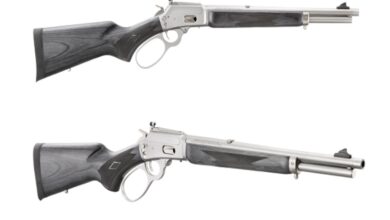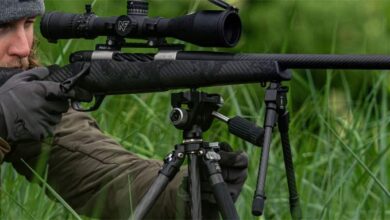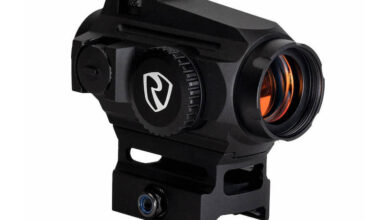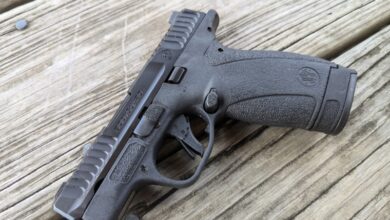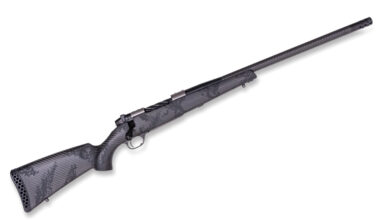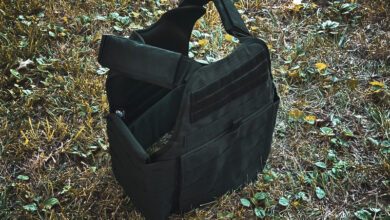Stargate vs The Tomorrow War: Who Did It Better?

I think every gun guy and gal who watched “The Tomorrow War” remembers the blaster featured in the film. There are two responses to that gun from gun guys and gals. The first is disgust and the folks who will pick the gun apart and talk about how stupid and silly it is. The second group will appreciate the weapon’s silliness and appeal to a futuristic aesthetic rather than any form of realism. The gun is known only as the MK III, but we all know it’s an AR variant covered in AR accessories. As a member of the latter group, I find joy in spotting real guns and gun parts in futuristic weapons. This was particularly evident when I recently revisited the “Stargate” movie.
I was drawn into the show and pleasantly surprised by its featured array of cool guns. The P90 is a classic, but who remembers the Carter Special Micro 16 Carbine? My jaw didn’t quite drop, but I was pleasantly surprised to see that the idea of the blaster in “The Tomorrow War” wasn’t new. What surprised me was that “Stargate” SG-1 Season 7 featured a rifle similar to the “The Tomorrow War” blaster. Let’s look at both today and argue about who did it better!
The MK III vs the Carter Special – The Blasters
Let’s do ladies first. The Carter Special, named for Major Samantha Carter in “Stargate,” uses an Olympic Arms K23B as its core rifle. This specific model is a full-auto, select-fire variant. The K23B was initially designed as a short-barreled rifle aimed at police entry teams. The gun used a very short 6.5-inch barrel and a proprietary gas tube shaped like a pig’s tail to provide adequate reliability.
A barrel this short loses so much velocity so fast that it’s almost comical. The noise, concussion, and muzzle blast make this a combination firearm, flash bang, and flame thrower. The K23B used a flat-top upper, but other K23 models had carry handles and front sights. The Carter Special was produced because P90 blanks were tough to come by, and with the GWOT roaring, they got expensive.
The gun at the heart of the MK III in “The Tomorrow War” appears semi-custom built. Xtreme Props created the gun from BCM receivers and has a BCM rail. As far as I can tell, the barrel length is eight inches, and BCM doesn’t make an eight-inch barrel. Eight inches is better than 6.5, but it’s still short. Typically, the shortest barrel accepted for a 5.56 AR is 10.5 inches.

The barrel length is designed to end where the front Hera grip ends and create a slick-looking platform. The BCM brand is known for unbeatable quality control, so it’s easy to understand why an armorer would choose its products. They are always in-spec and designed for heavy use, while blanks can quickly gum lesser weapons up.
I’m going to say that MK III wins this category.
The Furniture
The MK III keeps the BCM theme with a BCMH railed handguard. It’s tough to tell if it’s Keymod or M-LOK since every slot is covered in rails. The Carter Special goes with an early Bushmaster quad rail.
One of the defining features of the MK III is the furniture. It’s Hera CQC furniture, and the full set includes the fixed thumbhole stock and the oversized front grip. I don’t want to pick on Hera, but furniture like this doesn’t serve a purpose beyond being different and looking cool. For a futuristic movie about an invading bug species, it certainly looks cool. Hera takes some steps to add functionality to the furniture. The stock is fit with multiple sling points, and the grip features both a QD and U-LOOP point.
The Carter Special uses a Bell and Carlson thumbhole stock, which gives off the same vibes as the Hera stock. Bell and Carlson aren’t as well known today, but they famously produce thumbhole stocks for various firearms. They claim that the thumbhole stocks they design provide better stability for bench rest and offhand shooting. Is that true? If it was, I feel more people would use them, and it certainly doesn’t matter on a 6.5-inch AR.
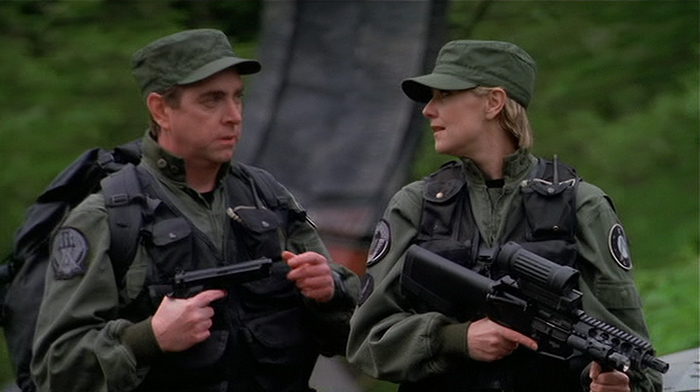
The front grip on this gun is a bit more tame and 100% necessary. It appears to be a simple KAC Broomstick foregrip. With a gun this short, there is barely anywhere to place your hand, and that rail likely gets nice and hot. The foregrip offers some stand-off space.
The Carter Special takes the win by being a little less extra and a little more practical.
The Optics
In the age of the Carter Special, the Elcan OS3 was hot stuff. This fixed power 4X scope gave you an up-close view of the battlefield compared to the irons most forces were still using. The Elcan is a beefy optic but also an indestructible one. I’m not sure how much range you’re getting with a 6.5-inch barrel, and the Elcan looks comically massive on the gun, but it admittedly stands out.
The MK III gets two optics. The first is the Trijicon ACOG, another fixed-power optic. They come in a few different magnification levels, but it’s likely a 4X model. This optic is smaller and lighter than the Elcan. It’s also proven to be pretty tough and was used by the USMC and Army for almost the entirety of the GWOT.
The MK III also has an offset red dot. It’s a Trijicon SRO. This is made for a pistol but offers a reflexive sight option if the fight gets too close to use the ACOG. It’s a smart addition, especially on a rifle with an 8-inch barrel. I’d assumed most fights are close.
Two is one, and one is none, so the MK III takes the lead.
Lights
I tried hard to find out if the light mounted on the Carter Special was anything more than a generic flashlight attached to a set of scope rings, but alas, I’ve come up short. I have to assume it’s just that. The little light is likely a low-powered flashlight of the era, which you can find at any Walmart or big box store.
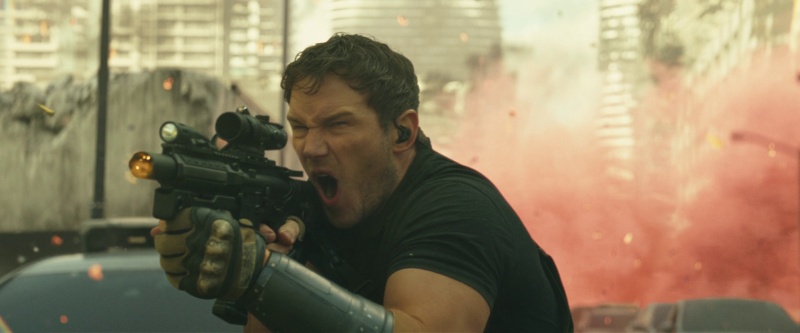
The MK III utilizes an Inforce WML Gen 2. This is a dedicated weapon light with a unique ramp-style switch. That switch makes it quite useable on the MK III with the top rail mount. The WML Gen 2 also packs much more power than a generic light from a hardware store. The Inforce isn’t everyone’s cup of tea, but it’s still a good choice for the MK III platform in both performance and style.
The MK III wins once more.
The Magazines
We are GunMag Warehouse, so we had to save the best for last. The Carter Special comes full bore with a massive Beta C-Mag drum. This 100-round drum gives her little rifle a lot of firepower. I guess if you have to deal with otherworldly bad guys every week, it makes a lot of sense to carry as much lead as possible. Not only that, but it adds to the over-the-top look of the Carter Special.
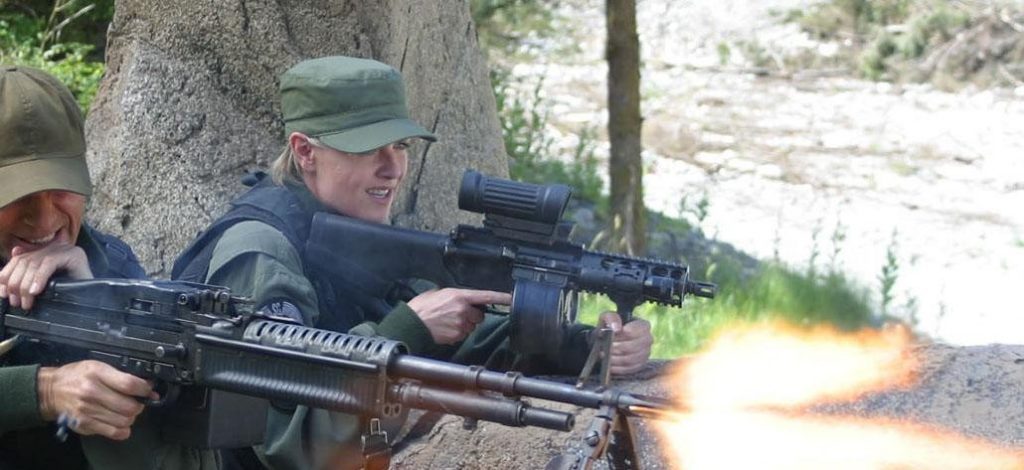
Let’s swing back to the MK III. What do we see? It’s PMAGs! It’s good to know Magpul is still in business in 2051 and producing magazines. If I were going to war against monstrous aliens, I’d also bring PMAGs. PMAGs are notoriously reliable and famously the choice of most professional gunfighters.
The Carter Special wins for style, but the MK III wins regarding performance.
The Real Winner
The MK III scrapes by with the win. It benefits from 20 or so years of weapon development and style, and that helps. The Carter Special can plant its flag and say we made the first nonsensical AR with a thumbhole stock! Speaking of, it’s odd that it has happened twice. Who do you think won? Let us know below!
The post Stargate vs The Tomorrow War: Who Did It Better? appeared first on The Mag Life.
Read the full article here

